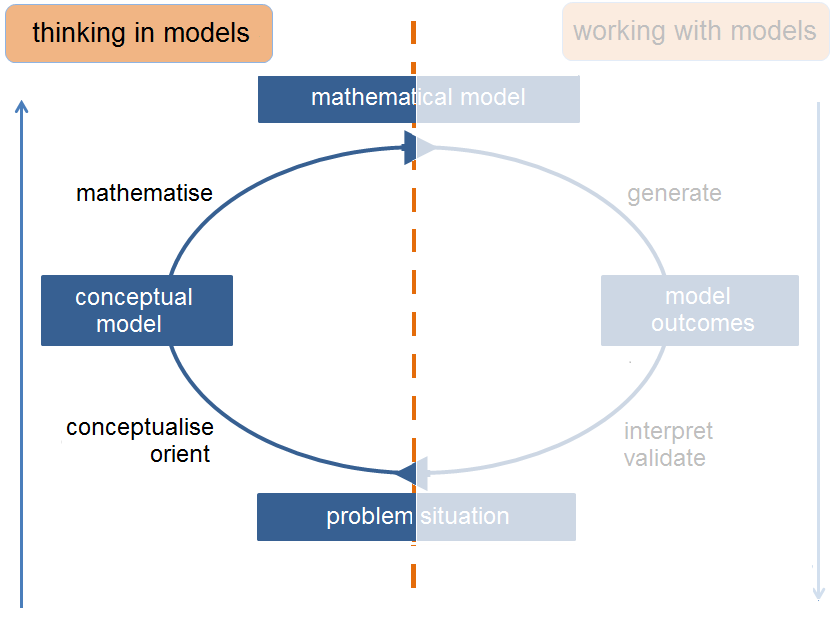3. Modelling learning path
3.3 Thinking in models
On this page and the page 3.4 Working with models we work out the Didactics of modelling into course elements that can occur in a particular order within the framework of a modelling task.1,2 Because inquiry-based modelling has lots in common with the goals of inquiry-based learning previously developed didactic schemas for inquiry-based learning can serve as guidelines, such as the internationally well-known 5E instructional model of Bybee: Engage, Explore, Explain, Extend (or Elaborate), Evaluate.3 The starting point in this guide is the modelling-oriented sequence of activities as shown in the modelling cycle: orientation, conceptualisation, mathematisation, generation of outcomes, interpretation, validation. This is in line with the attainment levels of the final examination in general secondary education (havo) and pre-university education (vwo).4,5
The course elements that play an essential role in development of models (thinking in models) are listed below. To illustrate the thinking steps that lead to a mathematical model, the subject of free fall in the school curriculum serves as one of the simplest examples of a dynamic model.

Fig 3.6 Thinking in models
- Preparation
In contexts that are new to students, the modelling task must be preceded by an explanation of the relevant scientific concepts and properties; relevant prior knowledge must be actively operationalised. Research shows that students often get stuck due to lack of basic knowledge and that modelling is not effective when it comes to learning basic concepts. The basic concepts and basic relationships must therefore be known in advance.6
Example: Free fall - Orientation
The problem situation or research question is introduced. It is discussed with students which physical processes play a role and for which applications this is important. The students determine which problem or which question is central, what is already known about it, and how this problem can be dealt with in steps.
Example: Free fall - Investigation
Students often have trouble imagining the concrete problem situation. This can be solved by systematically combining modelling with hands-on activities (experimenting and observing) in the learning path. Through these activities students familiarise with the situation and obtain data that are necessary to test the model.
Example: Free fall - Development of a model
In order to be able to translate the studied problem situation into a conceptual model, students must restrict the problem to a manageable problem. The teacher can provide support in various ways, such as asking questions, and identifying and naming relevant quantities and relationships in collaboration with the students. The teacher can stimulate students to design a visual model of elements and processes, and to make links with known relationships and principles. Depending on the level of the students, the model is described in mathematical and/or graphical terms.
Example: Free fall
The teaching practice of thinking in models is extensively described in the thesis of Onne van Buuren.7 Inspiration is also provided by Kelly O'Shea, physics lecturer at a progressive school in New York, who discusses in her blog8 how she combines modelling with practical work. The article Thinking like a scientist9 also emphasises a continuous interaction between thinking in models and hands-on experiences of students.